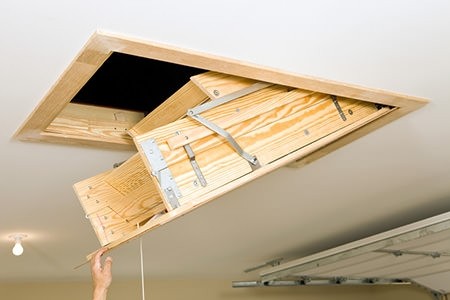
Pull-down attic stairs are super-sized attic hatches that just beg homeowners to store more stuff in their attic. Besides the air-leakage and insulation problems stemming from having a particularly large hole in your ceiling, pull-down stairs creates a potential storage headache.
For homeowners, a storage problem usually means “not enough space.” For energy auditors, a storage problem means using space that ought to filled with insulation for Timmy’s guitar, his old bike, Legos, his new bike, and the unpacked remains of twelve previous moves.
This aside was my way of saying: Let’s insulate and air seal pull-down attic stairs. You probably won’t stop using the attic for storage, but the wicked draft of cold air around the hatch won’t be missed.
A lot of heat is escaping from your house
Pull-down attic stairs are exactly what they sound like: a set of foldable stairs that can be pulled down for easy attic access. They usually come pre-installed with 1 inch of foam board insulation that is almost always worn through. (I’m not sure if the wear and tear is pre-installed.)
Pull-down attic stairs are horrifically leaky. It’s hard to pin down an exact figure to quantify the air leakage. (When home performance contractors address this type of air leakage, the repairs are almost always part of a larger air-sealing project.)
Important note: It is notoriously hard to quantify how much heat loss occurs through big holes in the building envelope like pull-down stairs. Our main quantitative tool, the blower door, forces a very abnormal condition from which it is difficult to extrapolate ‘normal’ conditions.
The best approach is just to find the biggest holes and seal them.
Products designed to seal or insulate attic stairs
Several companies sell prefacbricated foam or fabric enclosures or tents designed to reduce air leaks and heat loss at attic stairs. These products include:
Before purchasing one of these products, ask about the product’s R-value, and make sure that the length and width match those of your attic stairs. Remember: a site-built cap for your attic stairs — if it is well designed and well built — will probably perform better than any of these commercial solutions.
Air sealing the trim
A quick confession: this information on air sealing the trim was previously published in my article on sealing attic hatches. But the job is identical.
The first step is air sealing the finish trim and enclosure around the attic hatch. Carefully pull down the finish trim. (Pray that the installer used finish nails and not, say, ring-shank nails.)
Set aside the trim and, using caulk for smaller gaps (less than 1/4″) or foam sealant for larger ones, seal the gap between the attic hatch framing and the rough cut drywall. (I have to be just a shade vague there, as the drywall can either butt up against the hatch frame or lap over it).
Apply a bead of caulk on the inside and outside edges of the trim, and then reattach it.
Installing weatherstripping
Once the trim and frame are air-sealed, install either a heavy bulb weatherstrip or a sealing gasket (like the one on your refrigerator).
The gasket/weatherstrip would be installed on the top edge of the joists around the pull-down stairs.
The coffin
After installing the gaskets, build a plywood “coffin” (not to sound too ominous) to fit over the pull-down stairs in the attic. Measure the dimensions so that the interior perimeter of the coffin is flush with the inside edge of the joists that frame the opening.
Attach hinges to the box on the rear exterior (behind you as you walk up) fastened to the joists.
The end result should be a hatch that allows you to walk up and easily open it. Some people incorporate a weight and pulley system fastened to the overhead rafters to act as a counterweight. If you have a high level of blown insulation (18+ inches of loose fiberglass or cellulose, you may need to build a dam from plywood or foam board around the pull-down stairs. (I mean, unless you enjoy big face-fulls of insulation.)
Next, insulate
Add insulation to the exterior of the plywood box. With attic insulation, we aim for a pretty high standard — usually, at least R-49 — and the coffin insulation should match. That means that you should glue at least 4 inches of foil-faced polyisocyanurate (R-26) to the box. More insulation — 6 inches or 8 inches — isn’t uncommon.
Pull-down stairs provide very convenient access to an otherwise unusable space. Homeowners use attics to store vital unpacked boxes and old books. Sealing and insulating the attic pull-down stairs will at least make this a less egregious hole in the building envelope.
Erik North, the owner of Free Energy Maine, is an energy auditor and home performance specialist in Westbrook, Maine. He is also the author of the Energy Auditing Blog.
Weekly Newsletter
Get building science and energy efficiency advice, plus special offers, in your inbox.





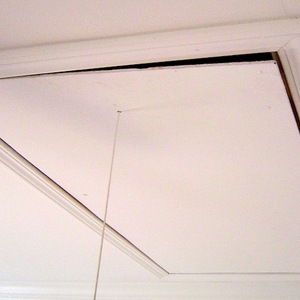
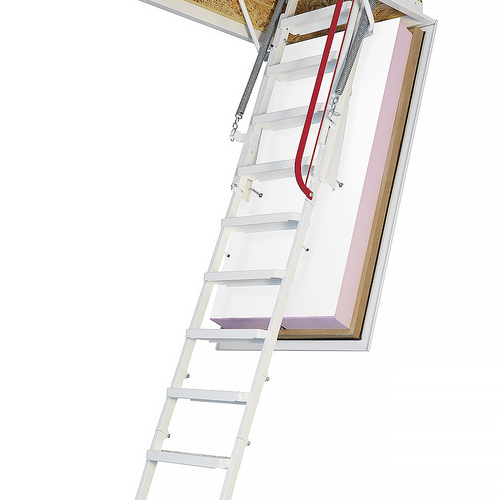
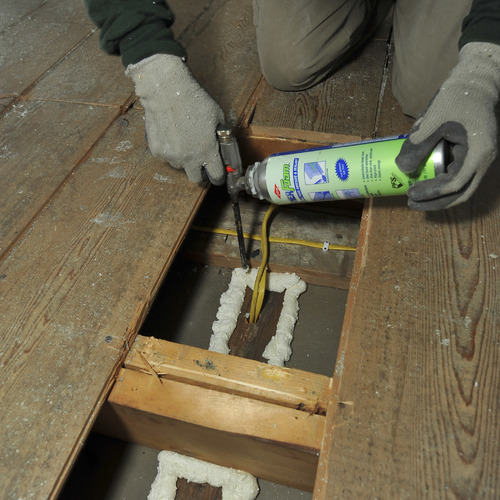
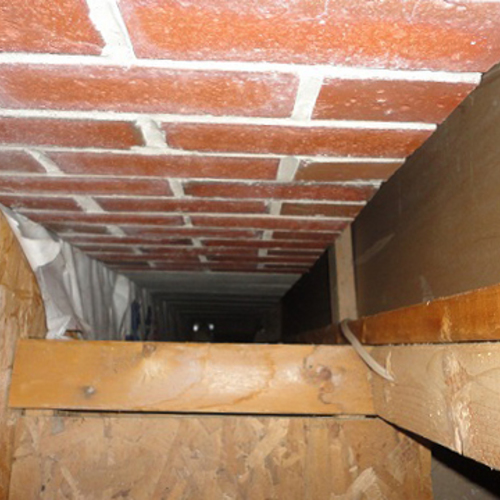






8 Comments
Death traps
I would also add to Erik's good info that most attic stairs are horrible and dangerous. Especially the stereotypical wooden ones shown in the photo. We encourage people to swap them out for better-built models. We like Rainbow's models, although they're pricey. They have some insulation, decent seals, etc. If you don't need the insulation, we've recently used Fakro's aluminum models and find them to be the most stable units we've ever installed.
Codes changes now require attic ladder to be insulated to R-30+
Due to the recent Code changes it may be difficult to select an insulated attic stair cover that meets the new Building and Energy Codes:
2009 IECC Section 402.2.3 and 2009 IRC Section N1102.2.3 and 2012 IECC Section R402.2.4 reads: "Access hatches and doors. Access doors from conditioned spaces to unconditioned spaces (e.g., attics and crawl spaces) shall be weatherstripped and insulated to a level equivalent to the insulation on the surrounding surfaces."
Energy Star Version 3 requirements conform with the 2009 IECC and 2009 IRC. The 2012 International Green Construction Code conforms to the 2012 IECC.
This means the attic access must now be insulated to the same level as the rest of the attic (min R-30 to R-49+).
Attic pull down insulation
Marc,
Great point. Given my druthers, I'd fit in a gable end access and do away with the attic hatch entirely. Hard to talk folks out of their storage space though.
That seems like an unusual code requirement
I understand that you would want the most insulation that is reasonably possible between your conditioned and unconditioned space—I know I would. But you're not required to have doors to the outside of your house insulated to the same level as the walls, so how can they expect folks to do that to doors within their house?
Converted It
My father had a similar situation in his '60s split-level. Not only did he have a pull-down stair into the attic (at the highest ceiling point no less) but there is a 32" whole-house fan right beside it and one of the return grills for his central AC (also in the attic) is very close. The highest point of the interior was Swiss cheese.
We removed the stair unit completely and constructed a rectangular hatch (gasketed; R-48 polyiso board on plywood) in its place. We also constructed a R-48 polyiso box in the attic over the hole-house fan and sealed the AC ductwork and any recessed lights. He got a new (much sturdier and less expensive) 8' aluminum step ladder for the Spring air handler filter cleaning ritual but everything else in the attic was removed and another 9" of fiberglass roll insulation added to the existing R-19 ceiling insulation. The improvements were immense! So much so that if he does not run the bathroom fan while showering he now gets condensation in some of the ceiling AC supply vents (hate that attic install!!!) - never did that before. Also removed the "cold hall" syndrome that has always been a part of the house.
Fortunately, he also has storage space above the unconditioned garage area that is even easier to access so he really doesn't miss the storage.
Add rigid insulation on back side of door?
In addition to building a box with a seal around it and a seal around the hatch itself, does it make sense to add rigid insulation to the back side of the hatch? I have space for 1/2 inch foam board & was thinking of also adding a sheet of rigid insulation. Admittedly doesn't help with air sealing, however it seems like it would be a cheap & easy addition to further insulate the hatch.
If you followed this approach, is there a particular type of rigid foam insulation you'd use?
Response to Robert Hallenbeck
Robert,
One half inch of rigid foam will provide between R-2 and R-2.5. That's not much.
If you want to gain that small R-value, you can do as you propose. However, it's important to make sure that the rigid foam doesn't interfere with the folding stairs or any of its hardware. Moreover, remember that the foam will get kicked every time someone uses the stairs -- meaning that it won't be very durable.
XPS foam is slightly denser and possibly more durable than EPS foam, but it is less environmentally friendly.
Good information, but this article needs more pictures or a drawing..
Log in or create an account to post a comment.
Sign up Log in